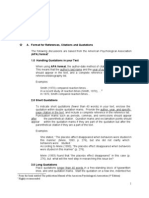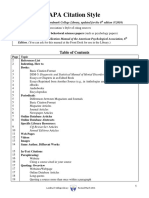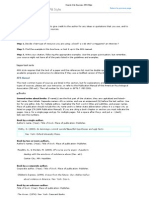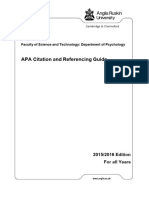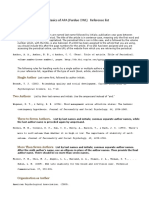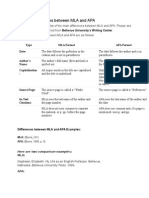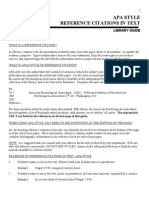American Psychological Association: Basic Structure
American Psychological Association: Basic Structure
Uploaded by
Shruti JhaCopyright:
Available Formats
American Psychological Association: Basic Structure
American Psychological Association: Basic Structure
Uploaded by
Shruti JhaOriginal Title
Copyright
Available Formats
Share this document
Did you find this document useful?
Is this content inappropriate?
Copyright:
Available Formats
American Psychological Association: Basic Structure
American Psychological Association: Basic Structure
Uploaded by
Shruti JhaCopyright:
Available Formats
APA format is the official style of the American Psychological Association and is used in most types of science and
social science writing. Before you create a reference page for your papers, essays, articles, or reports, it is important to learn how to format your references in proper APA style. The following examples and guidelines can help you prepare book references in proper APA format. Basic Structure: The basic structure of a book reference should list the author's last name, first initials, publication year, book title, location and publisher. Your reference should appear as follows: Author, I. N. (Year). Title of book. Location: Publisher. For example: Rogers, C. R. (1961). On becoming a person. Boston: Houghton Mifflin. Edited Book with One or More Authors: Edited books with one or more authors should follow the basic structure of a book reference
and include the initials, last name, and 'Ed.' in parentheses after the book title. For example: Adler, A. (1956). The individual psychology of Alfred Adler: A systematic presentation of selections from his writings. (H. L. Ansbacher & R. R. Ansbacher, Eds.). New York: Basic Books. Edited Book with No Author: Edited books with no author should list the last name and first initials of the editor or editors, followed by 'Ed.' or 'Eds.' in parentheses. The remainder of the reference should follow the basic structure and include the publication year, book title in italics, location, and publisher. For example: Atkinson, J. W. & Raynor, J. O. (Eds.). (1974). Motivation and achievement. Washington, DC: V. H. Winston. Article Featured in an Edited Book: Articles by individual authors that appear in edited books should list the last name and first initial of the author, followed by the publication
date and book title. Next, the editors should be noted followed by the location and publisher. For example: Bartol, C. R., & Bartol, A. M. (2005) History of Forensic Psychology. In I. B. Weiner & A. K. Hess (Eds.), The Handbook of Forensic Psychology (pp.1-27). Hoboken, NJ: Wiley. Translated Books: Books translated from another language should include the last name and first initial of the author, followed by the year of publication and book title. The first initials and last name of the translator and the notation 'Trans.' should then be included in parentheses. Next provide the location, publisher and a note of the original date of publication. For example: Freud, S. (1914). The psychopathology of everyday life. (A. A. Brill, Trans.). London: T. Fisher Unwin. (Original work published 1901). Tips:: 1. Remember that your reference page needs to be double-spaced.
2. The first line of each reference should be flush-left with the margin of the page. Each subsequent line of your reference should be indented.
APA format details a set of clear rules for referencing articles that appear in academic journals and other periodicals. Article references will vary somewhat based on where the article appears and who authored the content. The reference section is one of the easiest places to lose points due to incorrect APA format, so always check your references before you hand in your psychology papers. Learning to reference articles in proper APA format can help you throughout your study of psychology. Check out the following rules and guidelines for referencing articles in APA format. Basic Structure: Start by listing the authors last name and first initials, followed by the date of publication in parentheses. Provide the title of the article, but only capitalize the first letter of the title. Next, list the journal or periodical and volume
number in italics. Finally, provide the page numbers where the article can be found. For example: Author, I. N. (Year). Title of the article. Title of the Journal or Periodical, volume number, page numbers. or Smith, L. V. (2000). Referencing articles in APA format. APA Format Weekly, 34, 4-10. Magazine Articles: The structure for an article appearing in a magazine is similar to that of a journal article. However, the publication date should also include the month and day of publication. For example: James, S. A. (2001, June 7). Magazine articles in APA format. Newsweek, 20, 48-52. Newspaper Articles: References for newspaper articles follow the basic structure, but use the initials p. or pp. to denote page numbers. For example: Tensky, J. A. (2004, January 5). How to cite newspaper articles. The New York Times, pp. 4D, 5D.
You might also like
- Learning Guide Unit 1: Reading AssignmentDocument15 pagesLearning Guide Unit 1: Reading AssignmentMai Sayed100% (1)
- MOG1007 Assignment 1Document3 pagesMOG1007 Assignment 1Nitin SharmaNo ratings yet
- APA Quick Guide - Publication Manual of The American Psychological Association (APA)Document7 pagesAPA Quick Guide - Publication Manual of The American Psychological Association (APA)jesikamosleyNo ratings yet
- Put in Your Heading APA Referencing: Curtin University LibraryDocument11 pagesPut in Your Heading APA Referencing: Curtin University LibraryGanon DorfNo ratings yet
- How To Reference An Author or Authors in APA FormatDocument20 pagesHow To Reference An Author or Authors in APA FormatOdaa BultumNo ratings yet
- Summary of Guidelines For Formatting References According To The APA Style Guide: 6th EditionDocument15 pagesSummary of Guidelines For Formatting References According To The APA Style Guide: 6th EditionTaofan Charlotte EinsteinNo ratings yet
- APA Format References - How To List An Author or Authors in APA FormatDocument2 pagesAPA Format References - How To List An Author or Authors in APA Formatkeane1No ratings yet
- Referencing Guide 2012 (APA 6th Edition)Document7 pagesReferencing Guide 2012 (APA 6th Edition)Khai TongNo ratings yet
- Cream Purple Abstract Thesis Defense Presentation - 20240311 - 051511 - 0000Document22 pagesCream Purple Abstract Thesis Defense Presentation - 20240311 - 051511 - 0000catherineresolaNo ratings yet
- APA Complete Reference & Citation in Text StyleDocument15 pagesAPA Complete Reference & Citation in Text StyleazizmaarofNo ratings yet
- Summary of Guidelines For Formatting References According To The APA Style Guide: 5th EditionDocument15 pagesSummary of Guidelines For Formatting References According To The APA Style Guide: 5th EditionHanaeeyemanNo ratings yet
- A. Format For References, Citations and QuotationsDocument6 pagesA. Format For References, Citations and QuotationsehhunterNo ratings yet
- Reference in Journal and BookDocument1 pageReference in Journal and BookImtiaz SultanNo ratings yet
- APA Citation Guide 6th EdDocument19 pagesAPA Citation Guide 6th EdLautaro MaidanaNo ratings yet
- Apa Format Citing SourcesDocument2 pagesApa Format Citing SourcesClarence AbeledaNo ratings yet
- How To Write An APA Style BibliographyDocument3 pagesHow To Write An APA Style BibliographyFarid FirdausNo ratings yet
- APA 7th EDITION REFERENCE PAGEDocument54 pagesAPA 7th EDITION REFERENCE PAGEtiaraqueen100No ratings yet
- APA Style Guide 6 EditionDocument41 pagesAPA Style Guide 6 EditionFazal HayatNo ratings yet
- APA Style: Handling Quotations, Citations, and References: ExamplesDocument4 pagesAPA Style: Handling Quotations, Citations, and References: Examplesmaggiezhang598No ratings yet
- APAStyleDocument6 pagesAPAStyleguinevere_honeyNo ratings yet
- Apa Citations and ReferencesDocument4 pagesApa Citations and ReferencesLiezel SanchezNo ratings yet
- Citation in Reference ListDocument21 pagesCitation in Reference Listepy90No ratings yet
- Basic Rules of APA Style - Docx 1Document6 pagesBasic Rules of APA Style - Docx 1Saman Achakzai100% (1)
- Style For Writting ReferanceDocument8 pagesStyle For Writting ReferanceDelphy VargheseNo ratings yet
- Listing ReferencesDocument13 pagesListing ReferencesRHEA GENIONo ratings yet
- ApaDocument3 pagesApasumanlaudariNo ratings yet
- Guidelines Cite ReferencesDocument4 pagesGuidelines Cite ReferencesamboklateNo ratings yet
- Harvard Referencing SystemDocument4 pagesHarvard Referencing Systemthegluestick1No ratings yet
- Citing References PDFDocument27 pagesCiting References PDFNatalia MeoñoNo ratings yet
- 1 APA 6th EditionDocument4 pages1 APA 6th EditionIsabel Ise CostaNo ratings yet
- APA Referencing Guide: Title of Book (Rev. Ed.) - (Yyyy) - Location: PublisherDocument2 pagesAPA Referencing Guide: Title of Book (Rev. Ed.) - (Yyyy) - Location: Publisherberrie_blueNo ratings yet
- Apa Citation Style and Reference ListDocument9 pagesApa Citation Style and Reference ListAbz GaleNo ratings yet
- How To Cite Sources - APA StyleDocument21 pagesHow To Cite Sources - APA StyleSamantha G. FerrerNo ratings yet
- How To Write An APA Style BibliographyDocument4 pagesHow To Write An APA Style BibliographysumathichokkalingamNo ratings yet
- How To Document Sources in APA StyleDocument8 pagesHow To Document Sources in APA StyleFarid FirdausNo ratings yet
- APA 6 Style For Citing ReferencesDocument2 pagesAPA 6 Style For Citing ReferencestoombombNo ratings yet
- APA (6 Edition) Referencing Style: CitationDocument4 pagesAPA (6 Edition) Referencing Style: CitationSunday EnoNo ratings yet
- APA PresentationDocument37 pagesAPA PresentationPrince ShovonNo ratings yet
- APA Citation Style Refers To The Rules and Conventions EstabDocument9 pagesAPA Citation Style Refers To The Rules and Conventions Estabhauee circuitsoneNo ratings yet
- General Differences Between MLA and APADocument7 pagesGeneral Differences Between MLA and APAStephane PAGUIANo ratings yet
- Referencing Guide - 2012.doc - Referencing Guide 2015-16 (APA 6th Edition)Document10 pagesReferencing Guide - 2012.doc - Referencing Guide 2015-16 (APA 6th Edition)yustineponera65No ratings yet
- APA Style GuideDocument45 pagesAPA Style GuideVkey_1301100% (2)
- Citing Sources in The Text: Mla StyleDocument10 pagesCiting Sources in The Text: Mla StyleAmmirul ShafiqNo ratings yet
- Apa Reference Page TutorialDocument12 pagesApa Reference Page Tutorialapi-277513618No ratings yet
- Basic Form: Basics of APA (Purdue OWL) Reference ListDocument14 pagesBasic Form: Basics of APA (Purdue OWL) Reference ListNathaniel AlleyneNo ratings yet
- APA Style: How To Cite Sources: Basics of ResearchDocument24 pagesAPA Style: How To Cite Sources: Basics of ResearchFaten AteiaNo ratings yet
- (American Psychological Association) Style Is Most Commonly Used To Cite Sources Within The Social SciencesDocument21 pages(American Psychological Association) Style Is Most Commonly Used To Cite Sources Within The Social SciencesMichelle Baliwag DoceNo ratings yet
- APA Citing Format - 1Document18 pagesAPA Citing Format - 1Agnes LiewNo ratings yet
- APA ReferencesDocument32 pagesAPA ReferencesAhanaf RashidNo ratings yet
- What's A Bibliography?: References List Is Only Comprised of References To Those Items Actually Cited in The PaperDocument22 pagesWhat's A Bibliography?: References List Is Only Comprised of References To Those Items Actually Cited in The PaperAdonai Jireh Dionne BaliteNo ratings yet
- References in Educational ResearchDocument26 pagesReferences in Educational ResearchAditya .PNo ratings yet
- General Differences Between MLA and APADocument13 pagesGeneral Differences Between MLA and APAKyna Rae Sta Ana100% (1)
- How To Document Sources in APA Style: American Psychological Association, 6Document13 pagesHow To Document Sources in APA Style: American Psychological Association, 6izandmNo ratings yet
- APA Style ReferenceDocument36 pagesAPA Style ReferenceIrwan PrayudhiNo ratings yet
- RRL Referencing StylesDocument1 pageRRL Referencing StylesJason Pang-es LicosNo ratings yet
- Apa Format Guide DirectionsDocument6 pagesApa Format Guide Directionsapi-275510930No ratings yet
- APA Citation Style (Concordia Libraries)Document10 pagesAPA Citation Style (Concordia Libraries)Uyung YaskurNo ratings yet
- 3) APA - Citation - Style - Guide - (6th - Ed)Document12 pages3) APA - Citation - Style - Guide - (6th - Ed)Zhasmin ElmuratovaNo ratings yet
- Writing A BibliographyDocument6 pagesWriting A BibliographyJUVY GRACE ARANASNo ratings yet
- APA StyleDocument7 pagesAPA StyleJeffrey TehNo ratings yet
- A Brief History of Analytic Philosophy: From Russell to RawlsFrom EverandA Brief History of Analytic Philosophy: From Russell to RawlsRating: 4.5 out of 5 stars4.5/5 (3)
- 5901LHS Student Assessment Handbook 2024Document24 pages5901LHS Student Assessment Handbook 2024thanhthuyng.contactNo ratings yet
- Term Paper Sample Cover PageDocument5 pagesTerm Paper Sample Cover Pagedoawpfcnd100% (1)
- Apa 6 DissertationDocument5 pagesApa 6 Dissertationriteampvendell1979100% (2)
- APA Referencing GuideDocument4 pagesAPA Referencing Guideakshayah.varshaNo ratings yet
- Buy Ebook The Principles of Writing in Psychology 1st Edition T. R. Smyth Cheap PriceDocument84 pagesBuy Ebook The Principles of Writing in Psychology 1st Edition T. R. Smyth Cheap Pricetielegwandi100% (15)
- PHIL 342 Syllabus Bioethics F21 v1Document18 pagesPHIL 342 Syllabus Bioethics F21 v1Dr. philemon mwongeraNo ratings yet
- APA Citation GuideDocument19 pagesAPA Citation GuideElizabeth PerezNo ratings yet
- Shsres1 Module 3 RRLDocument19 pagesShsres1 Module 3 RRLnieljyepapel0No ratings yet
- Guide To Masters Thesis Dissertation FormatDocument18 pagesGuide To Masters Thesis Dissertation Formatdebbaghi.abdelkaderNo ratings yet
- How To Cite A Website in APA Style - Format & ExamplesDocument11 pagesHow To Cite A Website in APA Style - Format & ExamplesPatrick NumiNo ratings yet
- Tourism Culture and Communication GuidelinesDocument2 pagesTourism Culture and Communication GuidelinesKaran BerryNo ratings yet
- Vancouver Style Thesis CitationDocument5 pagesVancouver Style Thesis Citationchristinapadillareno100% (2)
- APR Part 2 Marking RubricDocument2 pagesAPR Part 2 Marking Rubricwanthing88No ratings yet
- Meeting 9: Setting Up The APA Reference Page: Course: Advanced Academic Writing Lecturer: Umiati Jawas, M.SC, PH.DDocument4 pagesMeeting 9: Setting Up The APA Reference Page: Course: Advanced Academic Writing Lecturer: Umiati Jawas, M.SC, PH.DcindyantNo ratings yet
- Apa Top 10 Cheat SheetDocument4 pagesApa Top 10 Cheat Sheetshakti vermaNo ratings yet
- Lyceum of The Philippines University Cavite Campus DOA Coecsa A.Y. 2020-2021Document7 pagesLyceum of The Philippines University Cavite Campus DOA Coecsa A.Y. 2020-2021Learnce MasculinoNo ratings yet
- Student Term Paper ExamplesDocument8 pagesStudent Term Paper Examplesdajev1budaz2No ratings yet
- Assignment OUMH1203 English For Written Communication September 2020 SemesterDocument6 pagesAssignment OUMH1203 English For Written Communication September 2020 SemesternannomansaranghaeNo ratings yet
- Thesis Outline Example ApaDocument8 pagesThesis Outline Example ApaAshley Hernandez100% (2)
- Writing, APA, Information Literacy, Organization, JLillibridgeDocument3 pagesWriting, APA, Information Literacy, Organization, JLillibridgeFlor OMNo ratings yet
- Citation ConventionsDocument11 pagesCitation ConventionsPinkyAngelx MspNo ratings yet
- Writing A Short Literature Review William Ashton PHDDocument4 pagesWriting A Short Literature Review William Ashton PHDafdtovmhbNo ratings yet
- PR1 W5-6Document39 pagesPR1 W5-6Gly HabinesNo ratings yet
- BCA - ENG I OrientationDocument44 pagesBCA - ENG I Orientationanudansainju.30732No ratings yet
- Writing Research Report: July 2016Document22 pagesWriting Research Report: July 2016Md. Faruq HasanNo ratings yet
- Dissertation BookDocument5 pagesDissertation BookCustomPaperServicesWashington100% (2)
- Course Outline: Engl225 (Academic Writing Ii)Document16 pagesCourse Outline: Engl225 (Academic Writing Ii)Ji-Shawn PardassieNo ratings yet
- Job Description Rubric - PSY 480Document3 pagesJob Description Rubric - PSY 480Madison HartfieldNo ratings yet











